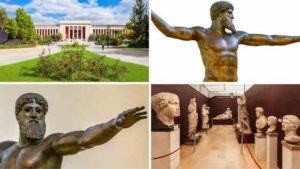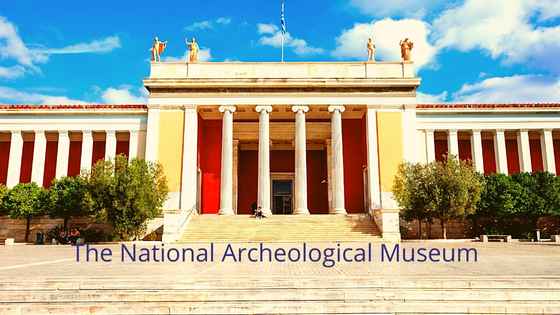The Acropolis Museum might be the museum that most people know when they visit Athens, but the National Archaeological Museum of Athens is the largest archaeological museum in Greece and contains the richest collection of findings from Greek antiquity worldwide.
Click below to read the article in Greek and listen to the audio
It was created with the aim to bring together under one roof antiquities from all over Greece, to protect and maintain them. The museum gives its local and international visitors the opportunity to learn more about ancient Greek history and appreciate its collection’s historical, cultural and artistic value. Keep reading to discover more about its history and its rich collection.
After the difficult Covid years, we are happy museums finally are open again. Hope you will be able to visit soon.
A bit of history about the National Archaeological Museum of Athens
The first national archaeological museum in Greece was founded by the Greek governor Ioannis Kapodistrias in Aegina, a small island close to the port of Piraeus, in 1829. As the collection grew, it kept moving from one exhibition place to another until 1889, when it was relocated to the current building.
During World War II, the museum was closed and the antiquities were sealed in special boxes and buried in order to keep them safe from destruction and looting. The exhibits saw the light of the day again in 1945.
Its collections
The National Archaeological Museum hosts a vast variety of collectibles from different regions of mainland Greece as well as the islands. Their time span covers the entire period from the Geometric to the Roman times. Here you can see unique finds from the Cycladic and Mycenaean civilizations, two of the most important ones to develop in ancient Greece, figurines from the Neolithic age, and many more.
An entire section has been dedicated to metalwork, where the visitors can familiarise themselves with its development and diversity between mainland and island regions of Greece. The metalwork collection includes religious items, warfare but also everyday life items such as tools and vessels.
Dating back to the 7th century BC, the museum’s sculpture collection includes a total of 17,000 sculptures, only 1,000 of which are currently on display. This section tells the story of ancient Greece all the way until it was conquered by the Romans in the 1st century AD. It illustrates beautifully the evolution of sculpture in Greece as well, showing how ancient Greeks transitioned from using wood and metal to using marble for sculptures, how the sculptures gradually became less static and showed more movement, and what were the ancient Greeks’ favourite themes for sculpting.

The museum is also home to a collection of Greek pottery and minor arts items which spans across 15 entire rooms – impressive, right? This means gold and silver jewels, paintings, glass vases and small artifacts made of ivory and bone, and many more. These items have reached the museum not only from mainland Greece and the islands, but from every single place that has been part of the Greek world at some point, including Asia Minor, Cyprus, Syria and Palestine, Egypt, Magna Graecia and Etruria (i.e. Southern and Central Italy respectively).
Location & access
The Museum is located in the Exarchia area of Central Athens, between the metro stop Omonia and Viktoria (both on the blue line), next to the historical building of the Athens Polytechnic University.
As with all Greek museums, the NAM was temporarily closed due to Covid-19 lockdown measures but since then, you can explore parts of its collection digitally here.
For more exhibition spaces and cultural activities to do in Athens, you can read our other articles on the
the Athens Museum of Contemporary Art (EMST)
the National gallery – Alexandros Soutzos Museum
as well as the Onassis Cultural Centre.




